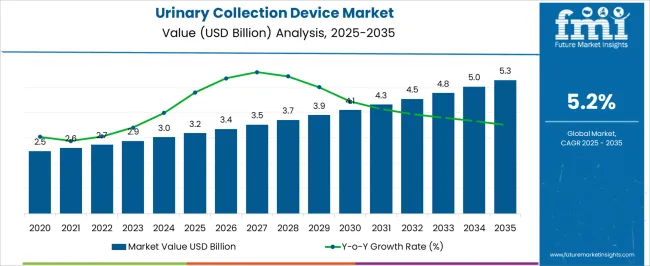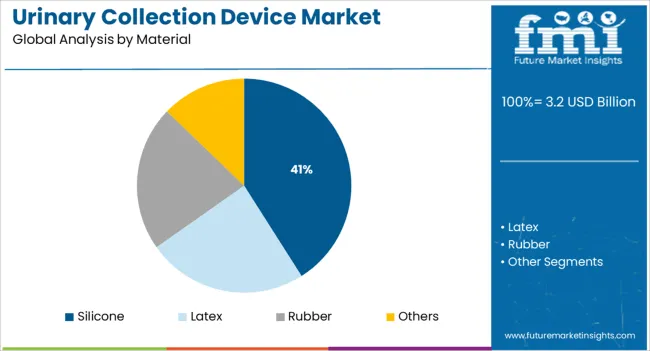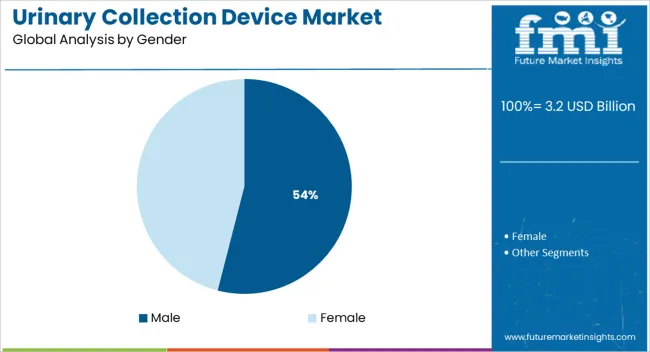The Urinary Collection Device Market is estimated to be valued at USD 3.2 billion in 2025 and is projected to reach USD 5.3 billion by 2035, registering a compound annual growth rate (CAGR) of 5.2% over the forecast period.

| Metric | Value |
|---|---|
| Urinary Collection Device Market Estimated Value in (2025 E) | USD 3.2 billion |
| Urinary Collection Device Market Forecast Value in (2035 F) | USD 5.3 billion |
| Forecast CAGR (2025 to 2035) | 5.2% |
The urinary collection device market is witnessing steady growth driven by the increasing prevalence of urinary disorders and rising geriatric population globally. Demand has been further fueled by advancements in medical device technologies that improve patient comfort and reduce infection risks. Healthcare providers are increasingly adopting innovative and biocompatible materials to enhance device safety and performance.
Additionally, growing awareness among patients and caregivers regarding urinary health management has supported broader adoption. Regulatory support for improved patient care standards and reimbursement policies are also contributing to market expansion.
Future opportunities are expected to arise from expanding outpatient care settings and home healthcare, which emphasize convenience and ease of use. Integration of antimicrobial coatings and ergonomic designs is paving the path for enhanced patient compliance and market penetration.
The market is segmented by Product, Material, Gender, and End User and region. By Product, the market is divided into Urinary Catheter, Urine Sample System, Urine Bags, and Accessories. In terms of Material, the market is classified into Silicone, Latex, Rubber, and Others. Based on Gender, the market is segmented into Male and Female. By End User, the market is divided into Hospitals, Clinics, Homecare Settings, and Others. Regionally, the market is classified into North America, Latin America, Western Europe, Eastern Europe, Balkan & Baltic Countries, Russia & Belarus, Central Asia, East Asia, South Asia & Pacific, and the Middle East & Africa.

When segmented by product, the urinary catheter segment is expected to hold the largest share of total market revenue in 2025, making it the leading product category. Its dominance is attributed to its widespread clinical use in managing urinary retention and incontinence across diverse patient populations.
The segment’s growth has been supported by continuous innovation in catheter designs that reduce discomfort and minimize infection rates. Hospitals and long-term care facilities have prioritized the use of advanced catheters to improve patient outcomes and comply with infection control protocols.
Additionally, cost efficiencies gained through reusable and coated catheter variants have contributed to increased adoption. These factors combined have reinforced the urinary catheter segment’s position as the market leader.

Segmented by material, silicone holds the leading share of the urinary collection device market in 2025. This predominance is driven by the material’s superior biocompatibility, flexibility, and resistance to bacterial colonization, which are critical factors for patient safety and comfort.
Medical institutions have increasingly favored silicone-based devices due to their lower risk of allergic reactions and improved durability compared to traditional materials. The capacity of silicone to maintain integrity during prolonged use has made it the preferred choice for both short-term and long-term catheterization.
Furthermore, advancements in silicone formulation and manufacturing techniques have enhanced its cost-effectiveness and availability, sustaining its leadership in the material segment.

When segmented by gender, the male segment is projected to account for the largest share of the urinary collection device market revenue in 2025. This leadership is largely explained by the higher incidence of urinary disorders affecting males, including benign prostatic hyperplasia and urinary retention, which necessitate frequent use of collection devices.
Healthcare providers and manufacturers have focused on developing male-specific designs that improve fit, comfort, and leakage prevention, thereby driving adoption. The segment’s prominence has also been supported by targeted awareness campaigns and increasing demand from aging male populations.
These elements have combined to maintain the male segment’s dominance within the market.
The market's expansion can be driven by the rising prevalence of chronic diseases among people globally and the increased use of these devices by patients with urine incontinence. The risk of urine incontinence in older people is increasing by a number of chronic illnesses and environmental factors. Diabetes, dementia, stroke, cancer, and arthritis are a few of the chronic conditions that are linked to urine incontinence. It is anticipated that the prevalence of these disorders will increase the risk of urine incontinence, which will increase the demand for urinary collection devices.
The rising frequency of chronic renal disease is another reason driving demand for urine collection devices. Nephrons are attacked by this condition which destroys them and impairs their ability to filter blood. As a result, fluid waste is deposited, leading to several complications. Patients with such conditions may experience urine incontinence or lose control of their bladder, which will ultimately expand the urinary collection device market to grow.
The urinary collection device market is broadly divided into seven major regions, North America, Latin America, Europe, East Asia, South Asia, Oceania, and the Middle East and Africa.
North America is the leading region in the global urinary collection device market due to the prevalence of chronic diseases and the presence of a strong healthcare network.
Apart from North America, the European urinary collection device market is also expected to display lucrative growth in the projected years due to the presence of major manufacturers in the industry and an aware populace.
The East Asian region is predicted to show lucrative growth owing to the vast untapped market and large geriatric population.
Teleflex Incorporated, Hollister Incorporated, Amsino International, Inc., Boston Scientific Corporation, B. Braun Melsungen AG, Medline Industries, Inc., Becton, Dickinson and Company (BD), Wihuri Packaging Oy, C.R. Brad, Coloplast.
| Report Attributes | Details |
|---|---|
| Growth Rate | CAGR of 5.2% from 2025 to 2035 |
| Base Year for Estimation | 2024 |
| Historical Data | 2012 to 2024 |
| Forecast Period | 2025 to 2035 |
| Qualitative Units | Revenue in USD Billion, Volume in Units, and CAGR from 2025 to 2035 |
| Report Coverage | Revenue Forecast, Volume Forecast, Company Ranking, Competitive Landscape, Growth Factors, Trends, and Pricing Analysis |
| Segment Covered | Product, Material, Gender, End User, Region |
| Region Covered | North America; Latin America; Europe; East Asia; South Asia; Oceania; Middle East Africa (MEA) |
| Key Countries Profiled | The USA, Canada, Brazil, Mexico, Germany, The UK, France, Spain, Italy, China, Japan, South Korea, Malaysia, Singapore, Australia, New Zealand, GCC, South Africa, Israel |
| Key Players | Teleflex Incorporated; Hollister Incorporated; Amsino International, Inc.; Boston Scientific Corporation; B. Braun Melsungen AG; Medline Industries, Inc.; Becton, Dickinson, and Company (BD); Wihuri Packaging Oy; C.R. Brad; Coloplast |
| Customization | Available Upon Request |
The global urinary collection device market is estimated to be valued at USD 3.2 billion in 2025.
The market size for the urinary collection device market is projected to reach USD 5.3 billion by 2035.
The urinary collection device market is expected to grow at a 5.2% CAGR between 2025 and 2035.
The key product types in urinary collection device market are urinary catheter, _indwelling catheter, urine sample system, _urine sample container, _urine sample tube, _urine sample bottle, urine bags, _urinary leg bags, _urinary drainage bags, _urinary belly bags and accessories.
In terms of material, silicone segment to command 41.0% share in the urinary collection device market in 2025.






Full Research Suite comprises of:
Market outlook & trends analysis
Interviews & case studies
Strategic recommendations
Vendor profiles & capabilities analysis
5-year forecasts
8 regions and 60+ country-level data splits
Market segment data splits
12 months of continuous data updates
DELIVERED AS:
PDF EXCEL ONLINE
Urinary Tract Infection (UTI) Treatment Market (UTI) Analysis - Size, Share, and Forecast 2025 to 2035
Urinary Bag Market - Trends & Forecast 2025 to 2035
Urinary Tract Infection Testing Market Analysis – Size, Share, & Forecast Outlook 2025 to 2035
Urinary Antibacterial & Antiseptic Pharmaceuticals Market Analysis – Forecast 2025 to 2035
Urinary Retention Therapeutics Market Growth - Demand & Forecast 2025 to 2035
Urinary Protein Reagents Market
Self-urinary Infection Testing Market Size and Share Forecast Outlook 2025 to 2035
Genitourinary Prosthetics Market Size and Share Forecast Outlook 2025 to 2035
Artificial Urinary Sphincter Market Size and Share Forecast Outlook 2025 to 2035
Complicated Urinary Tract Infections Treatment Market - Trends & Outlook 2025 to 2035
Uncomplicated Urinary Tract Infection Treatment Market Analysis by Penicillin, Quinolones, Sulfonamide, Nitrofuran, and Others Through 2035
Market Share Breakdown of Uncomplicated Urinary Tract Infection Treatment
Female Stress Urinary Incontinence Treatment Device Market Size and Share Forecast Outlook 2025 to 2035
Catheter Associated Urinary Tract Infections (UTI) Treatment Market - Demand & Forecast 2025 to 2035
Debt Collection Software Market Size and Share Forecast Outlook 2025 to 2035
Bile Collection Bags Market Size and Share Forecast Outlook 2025 to 2035
Blood Collection Devices Market Insights – Trends & Forecast 2025 to 2035
Evidence Collection Tubes Market Size and Share Forecast Outlook 2025 to 2035
Vacuum Blood Collection Device Market Analysis - Size, Share & Forecast 2025 to 2035
Assessing Vacuum Blood Collection Devices Market Share & Industry Trends

Thank you!
You will receive an email from our Business Development Manager. Please be sure to check your SPAM/JUNK folder too.
Chat With
MaRIA